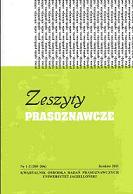Obraz konfliktu rosyjsko-gruzińskiego w 2008 roku w polskiej prasie drukowanej
THE POLISH NEWSPAPERS COVERAGE OF THE RUSSIAN-GEORGIAN CONFLICT IN 2008
Author(s): Agnieszka StępińskaSubject(s): Media studies
Published by: Wydawnictwo Uniwersytetu Jagiellońskiego
Keywords: national dailies in Poland; Russian-Georgian conflict in 2008; content analysis; press coverage of an event
Summary/Abstract: The aim of this paper is to present the results of a study on how the events in South Ossetia and Georgia in August 2008 were covered and interpreted by the newspapers in Poland. This study is a part of the international project that aims at conceiving a detailed overview of the news coverage in order to recognize how political analysis are shaped in and through journalism in five European countries, that is: Estonia, Finland, Germany, Poland and Sweden. This objective will be obtained by a combination of quantitative and qualitative analysis of the content of the major newspapers. It was Heikki Heikkila (University of Helsinki) who set a group of scholars and who created an original version of a codebook, then translated into languages of the countries involved. Due to the exploratory nature of the study, content analysis addresses the following research questions: (1) How the conflict in Georgia entered the news agenda? (2) How many items of a different genre were published in total by each media outlet? (3) What were the main sources of information published by the newspapers? (4) Who appeared as political analysts in opinion genres? (5) What kind of opinions were most frequently presented in the newspapers? The results showed that all the newspapers under the study supported Georgia in the conflict with Russia. Both journalists and political elites responded to the conflict consistently with the assumptions made on the past experience of the relations between Poland and Russia. Russia still has been perceived and portrayed as an enemy or a dangerous neighbor. There were, however, some differences among the newspapers as well. While Gazeta Wyborcza and Dziennik were focused mostly on reporting the events, Rzeczpospolita and Fakt paid much more attention to the interpretation. Furthermore, Rzeczpospolita was a newspaper with the highest number of the opinion items supporting Georgia, while Gazeta Wyborcza was the one that was giving the access to representatives of both sides of the conflict most frequently. At the same time, while comparing a number of the opinions supporting Georgia with a number of opinion items supporting Russia, it was Dziennik with the strongest loyalty toward Georgia. And Fakt, being a tabloid newspaper, provided mostly emotional arguments against Russia.
Journal: Zeszyty Prasoznawcze
- Issue Year: 209/2011
- Issue No: 1+2
- Page Range: 59-75
- Page Count: 17
- Language: Polish

